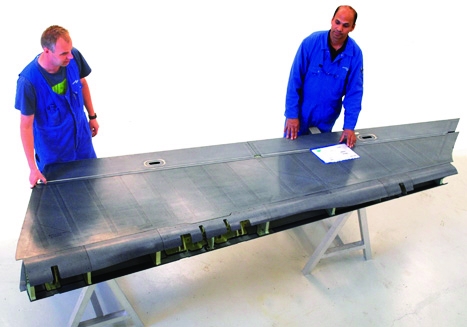
Until recently, primary aircraft structures were generally made from a combination of thermoset composites and aluminium. This year, however, all that changed when engineers at Netherlands-based Fokker Aerostructures announced that they had developed the world’s first induction-welded thermoplastic composite primary structures for the tail section of the new Gulfstream G650 aircraft.
The development of the composite rudder and elevator came about as the result of a co-operative effort between Fokker and a number of its key suppliers. Ticona, for example, provided its Fortron polyphenylene sulphide (PPS) thermoplastic polymer to Tencate Aerospace Composites, which used it to manufacture the carbon-fibre-based semipreg and plate materials.
From these materials, Fokker’s engineers produced ribs, skins and spars in box structures, which they then welded together to form the rudders and elevators using patented welding technology developed by Netherlands-based KVE Composites. This joins the components into an inseparable unit, eliminating costly drilling and riveting work.
Using a thermoplastic, rather than a traditional thermosetting composite, for the design of the rudder and elevator sections brought a number of advantages - according to Arnt Offringa, director of research and development at Fokker - not least of which was a reduction in both the cost and the weight of the manufactured parts.
It also enabled Fokker’s design team to create thermoplastic carbon-fibre post-buckled box-type structures with a large number of ribs and a solid laminate skin for both the rudder and tail sections. These have a high resistance to axial torsion, as well as a high resistance to buckling in their loaded sides.
’With thermoplastic composites, we used press forming to create the ribs in box-type structures - a very attractive proposition from a cost point of view. The manufacture of skin panels with thermoplastic composites was also a much faster process - the cycle time to autoclave the skins is much shorter than for alternative thermoset materials and the lay-up process is simpler,’ said Offringa.
Despite the fact that these composite-stiffened structures incorporating post-buckled designs offered weight savings of 10 per cent over earlier thermoset designs, Fokker also realised that attaching the ribs to the skins using conventional mechanical fasteners would be expensive. The company also knew that, because they were using thermoplastic composites, they could replace previously used bonding and riveting processes with automated welding.
By industrialising KVE Composites’ welding technology, Fokker’s engineers were able to assemble the low-weight multi-rib structures without being punished by inordinately high manufacturing costs.
According to Offringa, KVE’s welding technology can be used to join two carbon-reinforced composite elements - such as a rib to a skin, or a spar to a skin - through the use of an induction coil that moves along the parts to create a joint. The coil induces heat into the carbon fibres, which melts the surrounding polymer - thus creating the weld.
Despite the fact that the welding science was proven, it nevertheless took the Fokker engineers three years to refine it to a point at which it could be used in a manufacturing environment.
’It’s not easy to introduce a new manufacturing process, especially to produce a primary aircraft structure, and we had to perform a lot of testing before it could be used industrially - as well as prove its effectiveness and reliability to the airworthiness authorities,’ said Offringa.
Today, Offringa explained, Fokker has created a robot-based production cell at its factory in the Netherlands that uses the induction welding technique to weld the rudder and the two elevators of the new Gulfstream 650 aircraft. In use, the robot moves its induction coil along parts held in six jigs where three sets of ribs and three sets of spars are then welded to skins.
Once the welding process is complete, the finished parts are first visually inspected to determine whether a weld has been created, after which a non-destructive phased-array inspection system is moved along the weld line to verify the quality of the weld.
The Gulfstream 650 aircraft itself - replete with welded thermoplastic composite rudder and elevator - rolled out in September last year. It completed its first flight in November and is presently undergoing flight test and certification, a procedure that involves five aircraft and an estimated 1,800 hours of testing. The aircraft itself remains on schedule for entry into service in 2012.
production essentials
The key facts to take away from this article
- Carbon-fibre materials are used to create ribs, skins and spars
- These are then welded together to form rudders and elevators
- Thermoplastic structures are resistant to axial torsion and buckling
- Thermoplastic skin panels enable faster autoclaving and lay-up




IEA report claims batteries are ‘changing the game’
Oh I don't know. The typical waiting time outside of A&E for admitting patients would give them plenty of time to recharge … ?